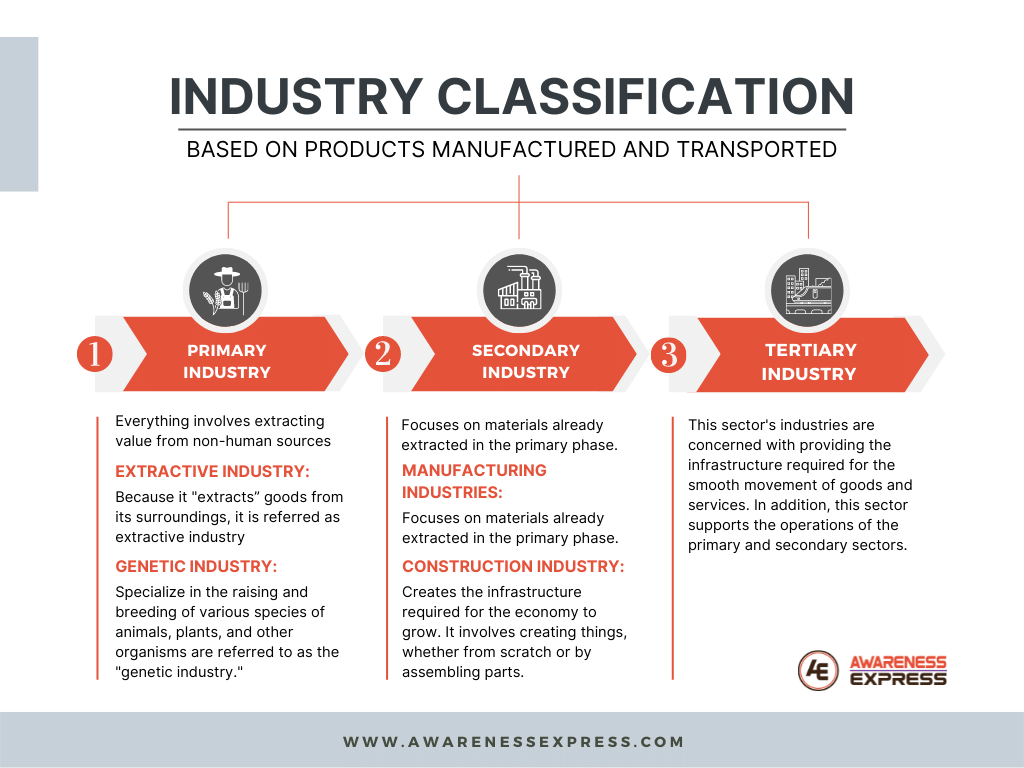Buying, selling, and exchanging products and services for a profit is what most people mean when they say “doing business.” The word ‘business’ derives from the prefix ‘busy.’ In a broader sense, “business activities” refers to any line of work in which people routinely perform tasks for monetary gain.
People may know about day-to-day business operations, but when it comes to classifying the same, they often get confused. Do not worry; in this write-up, we will address the question”how are businesses classified” but before that, let’s know about the Industry.
Industry
The economic activity that converts raw materials into finished goods is known as Industry. The term “industry” refers to producing and processing goods and rearing and reproducing animals and other life forms. The Industry’s goal is to maximize utility by converting inputs such as raw materials into outputs such as finished goods.
Industry Classification is based on products manufactured and transported

There are three major types of Industries:
- Primary Industry
- Secondary Industry
- Tertiary Industry
Primary Industry
Everything involves extracting value from non-human sources such as water, air, and land. Therefore, primary Industry includes the extraction and processing of natural resources, transportation, and utilities. To further classify these companies fall into the following categories:
Extractive Industry: Because it “extracts” goods from its surroundings, it is referred to as an extractive industry. The extractive industries rely heavily on raw materials primarily extracted from nature. These items are used to transform various new, valuable items. Extractive industries include agriculture, mining, lumbering, hunting, and fishing.
Genetic Industry: Businesses that specialize in the raising and breeding of various species of animals, plants, and other organisms are referred to as the “genetic industry.” The genetic industry includes a wide range of activities, such as dairy and poultry farms, plant nurseries, fish farms, etc., in which relevant traits are selected to produce a desirable end product.
Secondary Industry
This Industry focuses on the transformation of raw materials into finished goods. In other words, the secondary sector focuses on materials already extracted in the primary phase. Raw materials are transformed into finished products for sale or use in subsequent manufacturing steps in these sectors. Secondary industries can be further classified as follows:
Manufacturing industries:
Those industries are involved in transforming raw materials and semi-finished products into finished goods. These industries add value to society by converting raw materials into finished goods.
Manufacturing can produce either finished goods or tools and machinery. In addition, it can produce consumer goods or capital goods. Consumer goods include bread, butter, fabric, a radio, etc. These products have an immediate practical application for the end user.
Capital goods are used to create finished goods later in manufacturing, such as tools, pieces of equipment, and building machinery.
Manufacturing can be subdivided into:
a) The Analytical Industry: This industry analyses raw materials to transform them into numerous finished products. For example, kerosene, gasoline, and diesel are obtained by breaking down crude oil.
b) The Processing Industry: Before reaching the consumer, goods pass through several stages in this Industry. The output of one procedure becomes the input for the next, and so on, until the final procedure produces the final product. For example, cotton must first be ginned, woven, and dyed before it can be used to make cloth. Processing includes a wide range of industries, including sugar and paper.
c) The Synthetic Industry: Many different types of raw materials are combined in the manufacturing process of this Industry to produce a single finished good. For instance, cement requires various raw materials such as rocks, gypsum, coal, etc. Another example of a synthetic industry is the production of soap and paint.
Construction Industry:
The construction industry creates the infrastructure required for the economy to grow. It involves creating things, whether from scratch or by assembling parts. These companies produce buildings, roads, dams, bridges, and canals. These businesses rely on materials from other industries, such as cement, iron, bricks, wood, etc.
Tertiary Industry
This sector’s industries are concerned with providing the infrastructure required for the smooth movement of goods and services. In addition, this sector supports the operations of the primary and secondary sectors.
Industry Classification based on size

There are four distinct categories of business industries based on size, capital expenditure, workforce size, and output level.
Large-scale industries
It requires a capital investment of 10 crores or more to begin operations. The Industry employs many people and generates a substantial amount of revenue. Commodity businesses include the production of cotton, jute, textiles, banking, tourism, and so on.
Small Scale Industries
“Small-scale industries” refers to businesses with capital investment requirements ranging from 2 to 5 crores. The number of people involved in the industries and the amount of money they generate is relatively low. There are medium and small businesses, as well as cottage industries, in addition to large and small businesses.
Medium Scale Industries
The term “medium industry” refers to businesses that require start-up funding of between Rs.5 and Rs.10 crores ($80 million and $240 million). For example leather industry.
Cottage industries
They can be started with little money and run with the assistance of friends and family. When businesses are found in cities rather than rural areas, they are referred to as “urban cottage industries.” Pottery and basketry are two examples of such industries.
Light & Heavy Industries
The heavy Industry produces items such as machines, steel, and electricity. Extremely high capital expenditures and sophisticated manufacturing techniques are required to operate them, whereas light industries focus on producing goods for the general public. The manufacturing process is simple, and the technology and machinery used are inexpensive. Any endeavor undertaken to generate and acquire material wealth is referred to as a business. Business classification can be done on various parameters, but it is very general to differentiate businesses by industry. It is one of the simplest forms of classification, and once you learn about business classification based on industries, you can easily prepare an effective business plan based on your business type.









